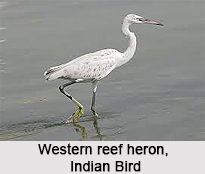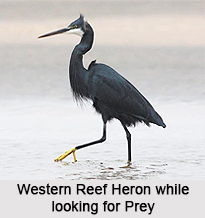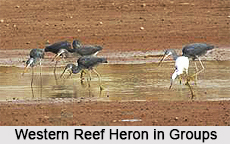 Western Reef Heron is an Indian bird with as a scientific name "Egretta gularis" also called the western reef egret, is a medium-sized heron found in southern Europe, Africa and parts of Asia.
Western Reef Heron is an Indian bird with as a scientific name "Egretta gularis" also called the western reef egret, is a medium-sized heron found in southern Europe, Africa and parts of Asia.
Concentration of Western Reef Heron
Western Reef Heron has a mainly coastal distribution and occurs in two plumage forms, a slaty-grey plumage in which it can only be confused with the rather uncommon dark morph of the little egret and a white form which can look very similar to the little egret although the bill tends to be paler and larger.
Sizes of Western Reef Heron
There are also differences in size, structure and foraging behaviour. There have been suggestions that the species hybridizes with the little egret, and based on this, some authors treat schistacea and gularis as subspecies of Egretta garzetta. Works that consider the western reef heron as a valid species include the nominate gularis and schistacea as subspecies.
Colours of Western Reef Heron
Western Reef Heron has two plumage colour forms. There is an all-white morph and a dark grey morph; morphs can also occur with intermediate shades of grey which may be related to age or partly-coloured in grey and white. The white morph is similar in general appearance to the little egret, but has a larger yellowier bill, extended yellow on thicker legs, and when foraging tends to be very active, sometimes also moving its wing or using it to shade the water surface. The grey morph has a whitish throat and is unlikely to be confused with any other species within the range of this egret with beak and legs similar to that of the white morph. During the breeding season the legs and facial skin are reddish.
Breeding of Western Reef Heron
Breeding birds of Western reef heron have two long feathers on the sides of the nape. The nominate subspecies gularis has a range from West Africa to Gabon, with some birds breeding in southern Europe. Subspecies schistacea breeds from the Persian Gulf along the coast of India to the east of the India Peninsula. The form on the eastern coast of South Africa is usually separated as the dimorphic egret Egretta dimorpha. The dark and white morph is thought to be controlled by a single allele with the dark character being incompletely dominant over the gene for white.
History of Western Reef Heron
Western Reef Heron was first described as Ardea gularis from a specimen obtained in Senegal by the French naturalist Louis Augustin Guillaume Bosc in 1792. The distinctive white throat (or gular region) in the dark morph gives it the species name.
Concentration of Western Reef Heron
Western Reef Heron is concentrated in Krishna Wildlife Sanctuary in India. Eastern great egret occurs mainly on the coasts in tropical west Africa, the Red Sea, the Persian Gulf (Iran) extending east to India. It also occurs in the Lakshadweep Islands and Sri Lanka where breeding was once recorded at Chilaw. The nominate subspecies breeds in west Africa from Mauritania to Gabon. Birds may also be found off the mainland such as in the Canary Islands. Small numbers breed in Spain. Subspecies schistacea is found from the Red Sea coast east round the Indian coast. Breeding colonies are known from the east coast of India around Pulicat Lake. They occasionally occur in further inland.
Feedings of Western Reef Heron
Western Reef Heron stalk their prey in shallow water, often running or stirring the water with their feet or flicking their wings to disturb prey; they may also stand still and wait to ambush prey. They eat fish, crustaceans, and molluscs. In coastal areas, they regularly feed on mudskippers.
Sexes of Western Reef Heron
In India the breeding season of Western Reef Heron is during the monsoon rains from April to August and end of May in the former breeding colony at Chilaw in Sri Lanka. Most of the breeding colonies in Gujarat in western India were on mangroves. They nest in colonies usually of their own species but sometimes with other egrets and smaller herons, usually on platforms of sticks placed in trees or shrubs. The male fetches sticks of the nest while the female places them to form the platform. The nest height varies from about 5 to 15 meters, but very low nesting (as low as 0.6 meters) has been observed in mangrove trees in salt pans.
Eggs of Western Reef Heron
The usual clutch of Western reef heron is three to four eggs which are light blue as in the little egret. The incubation of Western reef heron begins when the first egg is laid resulting in chicks with size disparities. Both parents take turns to incubate and the eggs hatch after about 23 to 24 days. The chicks of Western reef heron are white with grey dapples. The Young Western reef heron birds sometimes die after falling off from the nest platform. Adult Western reef herons will shade the chicks during the hotter parts of the day. Predators of eggs include rats and young chicks may be taken by cats and crows. Adults usually guard the nest when eggs or young chicks are present. Western reef heron feed the young by regurgitating semi-digested food at the nest. This diet of Western reef heron includes mainly small fishes of the families Clupeidae, Gobiidae and Engraulidae. Western reef heron leave the nest after about a month.



















